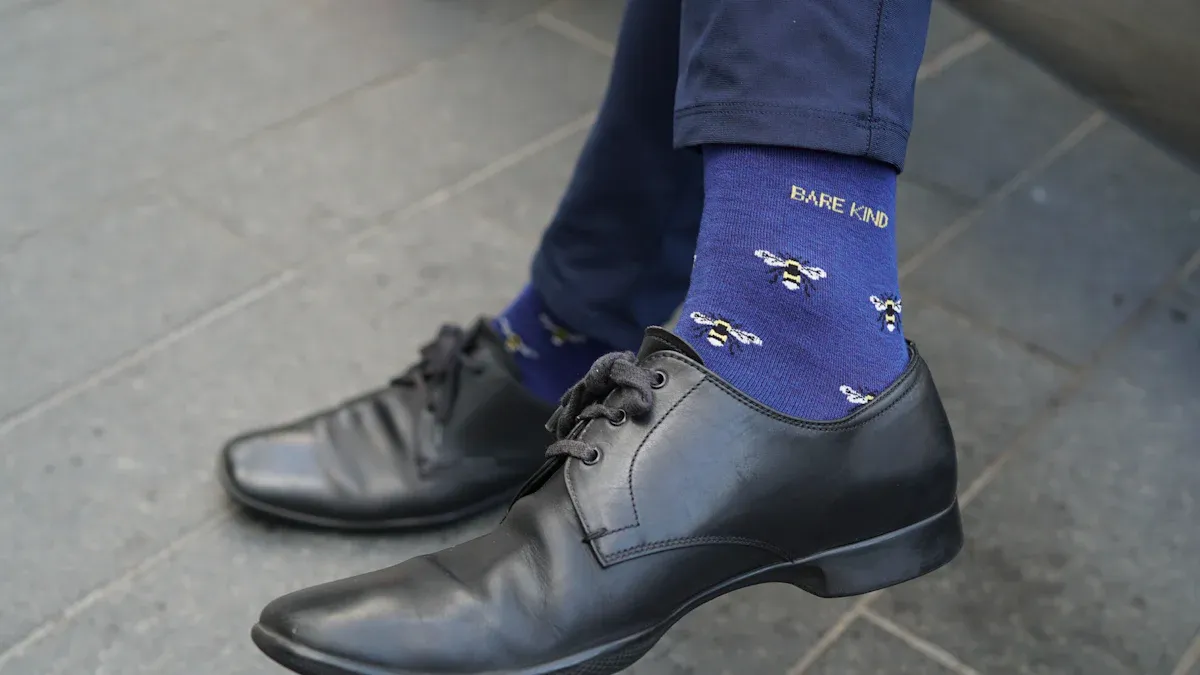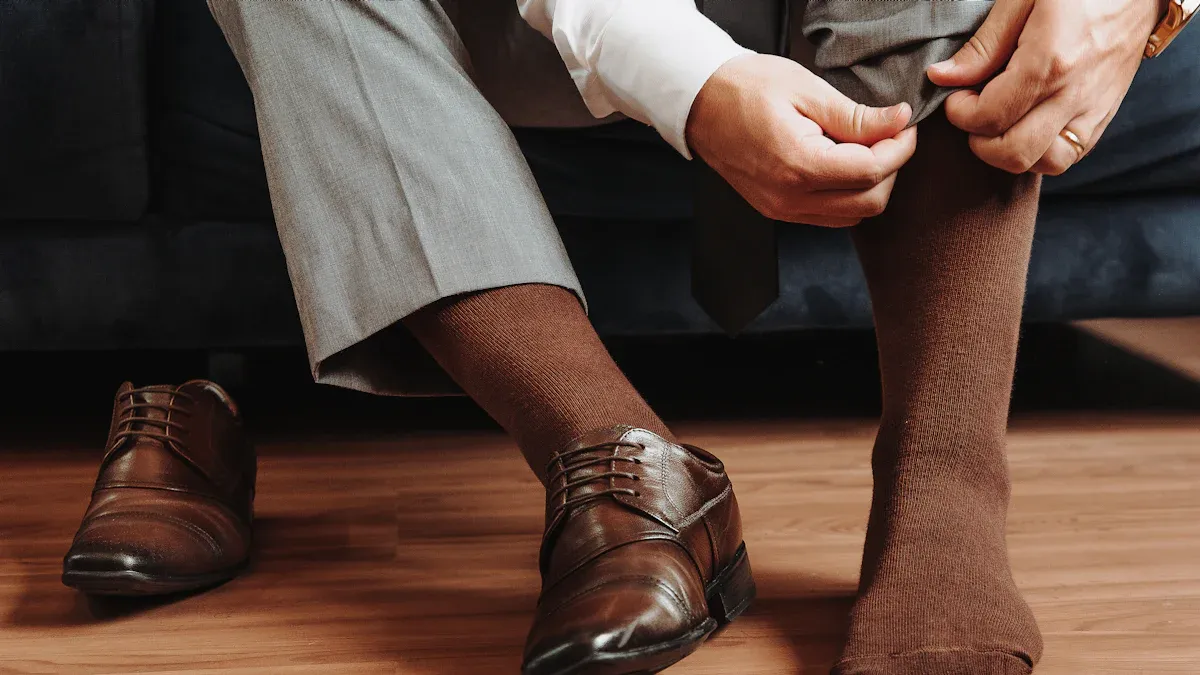
You may have noticed that men rarely pair short socks with dress shoes. This choice is not random.
Short socks disrupt the polished look expected in formal settings. They fail to provide the comfort and protection you need throughout the day.
Additionally, traditional dress codes often discourage their use, favouring long socks for a more professional appearance.
Key Takeaways
- Long socks give a neat look with dress shoes. They help match formal dress rules.
- Long socks feel comfy and protect feet. They stop rubbing and blisters when wearing dress shoes for hours.
- Short socks can work for casual outfits. But long socks are better for a smart and classy style.
What Are the Aesthetic Reasons Behind Avoiding Short Socks with Dress Shoes?
Disrupting the Polished Look
Short socks can disrupt the polished look that dress shoes and formal attire aim to achieve. Imagine wearing stark white athletic socks with a tailored suit and leather shoes. This combination creates a jarring contrast, similar to pairing trainers with a tuxedo. It signals a lack of attention to detail and undermines the sophistication of your outfit. The visual harmony between your socks, trousers, and shoes plays a crucial role in maintaining a refined appearance.
The Gap Between Trousers and Socks
When you sit or cross your legs, short socks often expose a gap of bare skin between your trousers and socks. This gap draws attention and breaks the continuity of your outfit. It can make your attire appear incomplete or even sloppy. Long socks, on the other hand, ensure that no skin is visible, preserving the seamless flow from your trousers to your shoes. This small detail significantly impacts how others perceive your overall look.
Formality and Elegance of Long Socks
Long socks exude formality and elegance, which short socks fail to replicate. Visual studies suggest that aesthetic responses are shaped by emotional experiences and visual appeal. The style and length of your socks communicate values such as professionalism and attention to detail. Long socks align with these expectations, enhancing the visual compatibility of your outfit. They also evoke a sense of tradition and respect for formal dress codes, which short socks often lack.

What Functional Concerns Make Men Avoid Short Socks with Dress Shoes?
Comfort and Skin Protection
Long socks provide better comfort and protection for your skin compared to short socks. They cover more of your legs, shielding your skin from direct contact with your trousers. This prevents irritation caused by rough fabrics or seams rubbing against your skin. Long socks also stay in place throughout the day, ensuring consistent coverage and avoiding the discomfort of socks slipping down. You can focus on your tasks without the distraction of adjusting your socks repeatedly.
Preventing Chafing and Blisters
Wearing long socks reduces the risk of chafing and blisters, especially during long hours in dress shoes. Short socks often leave parts of your feet and ankles exposed, increasing friction between your skin and the shoe. Long socks, particularly those made from synthetic materials, wick away moisture and minimise friction. Choosing high-quality, form-fitting socks further enhances protection. Compression socks, for instance, provide a snug fit and prevent seams from rubbing against your toes. Double-layer socks are another excellent option, as they reduce friction and keep your feet dry, lowering the chances of blisters.
Hygiene and Sweat Absorption
Long socks play a crucial role in maintaining hygiene and absorbing sweat. Dress shoes often lack ventilation, causing your feet to sweat more. Short socks fail to absorb this moisture effectively, leading to unpleasant odours and potential bacterial growth. Long socks, especially those made from breathable fabrics, help wick sweat away from your skin. This keeps your feet dry and reduces the risk of fungal infections. By wearing long socks, you ensure a cleaner and more comfortable experience throughout the day.

How Do Cultural and Social Norms Influence Sock Choices with Dress Shoes?
Traditional Dress Codes
Traditional dress codes have long dictated the appropriate pairing of socks with formal attire. These guidelines emphasise the importance of maintaining a cohesive and polished appearance. Long socks align with these expectations by ensuring no skin is visible when you sit or move. Short socks, on the other hand, often fail to meet these standards. They expose your ankles, which can disrupt the formal aesthetic. By adhering to traditional norms, you demonstrate respect for the occasion and the people around you.
Professional Expectations
In professional settings, your attire communicates your level of seriousness and attention to detail. Wearing long socks with dress shoes signals professionalism and a commitment to maintaining a polished look. Short socks, however, can give the impression of carelessness. This small detail might seem insignificant, but it can influence how colleagues and clients perceive you. Choosing long socks helps you project confidence and competence, which are essential in the workplace.
Fashion Etiquette and Trends
Fashion etiquette often evolves, but some principles remain constant. Long socks have consistently been associated with elegance and formality. While modern trends occasionally embrace short socks or no-show socks, these styles are usually reserved for casual or semi-formal occasions. Following established etiquette ensures your outfit aligns with the expectations of the setting. It also shows that you understand the balance between tradition and contemporary fashion.

Are There Any Exceptions or Stylish Alternatives to Traditional Dress Socks?
When Short Socks Are Acceptable
Short socks are rarely suitable with dress shoes, but there are exceptions. Casual events or semi-formal gatherings may allow you to experiment with shorter sock styles. For instance, pairing short socks with loafers or brogues can work if the setting is relaxed and your outfit leans towards smart-casual. However, you should ensure that the socks complement your trousers and shoes in colour and texture. This approach helps maintain a cohesive appearance, even in less formal situations.
Warm weather also provides an opportunity to wear short socks. Lightweight fabrics and breathable designs can keep your feet cool while offering some level of comfort. Yet, you must remain cautious. Exposed skin between your trousers and socks can still disrupt the overall look, so consider the occasion carefully before making this choice.
No-Show Socks as an Option
No-show socks have gained popularity as a modern alternative to traditional styles. These socks remain hidden beneath your shoes, giving the illusion of bare ankles while still providing comfort and hygiene. Many young adults and working professionals prefer no-show socks for their versatility. According to market research, 65% of young adults prioritise sock styles that blend with footwear, while 58% of professionals use no-show socks for both office and casual wear.
Urban areas, influenced by social media trends, show a higher interest in these socks. They are particularly popular during warmer months, with nearly half of purchases occurring between April and August. If you value sustainability, you can find eco-friendly options that align with modern consumer preferences. No-show socks offer a practical solution for those seeking a balance between style and comfort.
Modern Fashion Adaptations
Fashion continues to evolve, and modern trends have introduced new ways to style socks with dress shoes. Designers now experiment with bold patterns, vibrant colours, and unique materials to create statement pieces. While long socks remain the standard for formal occasions, contemporary styles allow you to express individuality in less rigid settings.
For example, pairing patterned socks with tailored trousers can add a playful touch to your outfit. Similarly, minimalist designs in neutral tones can complement modern, sleek footwear. These adaptations reflect a shift towards personal expression while respecting traditional norms. By embracing these trends, you can stay stylish without compromising on elegance.

Conclusion
Long socks remain the ideal choice when you wear dress shoes. They ensure a polished look, provide comfort, and respect cultural norms. Exceptions, like no-show socks, suit casual or warm-weather settings. By choosing the right socks, you maintain elegance and adapt to modern trends without compromising professionalism.
FAQ
Why are long socks considered more professional than short socks?
Long socks ensure no skin shows when you sit or move. This maintains a polished, professional appearance that aligns with traditional dress codes and workplace expectations.
Why do short socks cause discomfort with dress shoes?
Short socks expose your skin to direct contact with shoes and trousers. This increases friction, leading to irritation, chafing, or blisters during prolonged wear.
Why are no-show socks not suitable for formal occasions?
No-show socks create a casual look by exposing your ankles. This disrupts the formal aesthetic required for professional or traditional settings, making them unsuitable for such occasions.
